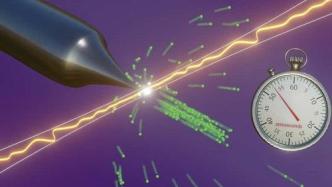

The shortest electron pulse so far has a duration of only 53 attoseconds. British New Scientist
German scientists have captured a record-breaking shortest electron pulse - only 53 attoseconds (1 attosecond is 10-18 seconds). It's fast enough for more precise electron microscopes to capture sharp, still images at the atomic level, rather than blurry ones. It also speeds up data transfers on computer chips. Related papers were published in Nature on January 25.
Pulses of electrons are used to represent data inside a computer or to capture images in an electron microscope. The shorter the pulse, the higher the information transfer rate. Researchers such as Eleftherios Goulielmakis of the University of Rostock have been working on reducing the length of such pulses as much as possible.
The electron pulses generated by electric fields in ordinary circuits are limited by the frequency at which electrons oscillate within the material. A pulse needs to last at least half the period of the oscillation, and it is this period that creates the "push" for the electrons, Goulielmakis said.
Light oscillates at a much higher frequency, so Goulielmakis' team has been using short bursts of light to trigger pulses of electrons. In 2016, the team created a burst of visible light that lasted just 380 attoseconds. Now, the team uses the same technique to focus a laser and shoot electrons from the tip of a tungsten needle into a vacuum.
The 53-attosecond electron pulse they detected was even shorter than the light pulse that triggered it. According to Bohr's model of the hydrogen atom, it lasts one-fifth of the time it takes an electron in a hydrogen atom to orbit the nucleus, Goulielmakis said.
Such short pulses of electrons allow the electron microscope to focus on shorter time slices, similar to slowing down the shutter speed of a camera, revealing the motion of particles more clearly.
"Sometimes (in electron microscope images) you see the atoms are a bit blurry. It's not necessarily because they're not well resolved, but because the electrons aren't stationary at a particular point, forming a cloud around the atom. And attosecond electron pulses will help enhance the resolution to capture electrons in motion."
"If you create an electron microscope using attosecond electron pulses, then we can not only look at atoms in motion with enough resolution, but even see how electrons jump between those atoms," Goulielmakis said. "It will be exciting." thing."
(Originally titled "The Shortest Electron Pulse in History")